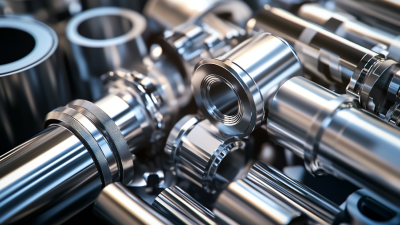 +86 13794985240
+86 13794985240
Leave Your Message
-
 CONTACT NUMBER
CONTACT NUMBER -
 CONTACT NUMBER
CONTACT NUMBER -
 CONTACT NUMBER
CONTACT NUMBER



In the realm of hydraulic equipment, the Bucket Cylinder has emerged as a cornerstone of innovation, playing a crucial role in enhancing operational efficiency across various sectors. According to a recent industry report by TechNavio, the global market for hydraulic cylinders is expected to grow at a CAGR of 4.5% through 2025, driven primarily by advancements in technology and increased demand from the construction and manufacturing industries. This upward trend highlights the importance of understanding the latest developments in bucket cylinder technology, as these innovations could significantly impact productivity and performance.

As we look towards 2025, it’s essential to identify the top innovations in bucket cylinder technology that are set to redefine industry standards. With the rise of automation and the Internet of Things (IoT), the integration of smart sensors and real-time monitoring systems into bucket cylinders demonstrates a substantial leap forward in operational capabilities. Additionally, advancements in materials and manufacturing techniques are leading to more durable and efficient designs, which are pivotal in meeting the rigorous demands of modern applications. By exploring these innovations, industry professionals can better position themselves to leverage new opportunities and optimize their processes.
Recent advancements in materials science have significantly impacted the durability and performance standards of bucket cylinders. The use of emerging composite materials, such as carbon fiber-reinforced polymers, has shown to increase the tensile strength of bucket cylinders by up to 30%, as indicated in a 2022 report by the International Mechanical Engineering Congress. These materials not only enhance strength but also reduce weight, which can lead to improved energy efficiency in machinery applications.

Additionally, improvements in surface coatings have contributed to enhanced wear resistance and longevity of bucket cylinders. According to a study published by the American Society of Mechanical Engineers (ASME), innovations such as advanced ceramic coatings can extend the service life of bucket cylinders by 50% compared to traditional materials. These advancements are crucial for industries that rely heavily on bucket cylinders, such as construction and agriculture, where equipment durability directly affects operational efficiency and maintenance costs. As these technologies continue to evolve, they promise further advancements in the performance standards of bucket cylinders in the coming years.
The integration of smart technology in bucket cylinder operations represents a significant leap forward in efficiency and control. By harnessing IoT features, these systems can collect and analyze data from various sensors to optimize performance. This automation facilitates real-time monitoring, enabling operators to quickly respond to changes in environmental conditions or machinery status. Consequently, it reduces downtime and improves operational safety, as real-time alerts can prevent potential malfunctions.
Moreover, the synergy between AI and IoT plays a crucial role in enhancing bucket cylinder technology. AI algorithms can process the data collected by IoT devices, allowing for predictive maintenance and more intelligent decision-making. This interaction minimizes the need for manual intervention, streamlining workflows and reducing human error. As the industry moves toward fully automated solutions, the implementation of these smart technologies will not only enhance productivity but also pave the way for innovative applications in various industrial sectors.

In recent years, the bucket cylinder industry has made significant strides towards sustainability, with an increasing emphasis on eco-friendly innovations in production processes. Companies are now leveraging recycled materials to manufacture bucket cylinders, which not only reduces waste but also cuts down on the energy consumption associated with producing new materials. This shift towards a circular economy helps to minimize the environmental impact of bucket cylinder production while meeting the growing demand for sustainable industrial solutions.
Tips for choosing eco-friendly bucket cylinders include checking for certifications that indicate the use of recycled materials and evaluating manufacturers’ commitment to sustainability practices. Additionally, consider products that utilize energy-efficient production techniques, as these often translate to lower emissions and a reduced carbon footprint.
Furthermore, advancements in biodegradable synthetic materials are gaining traction, offering alternatives to traditional plastics. This innovative approach not only improves sustainability but also aligns with consumer preferences for greener products. By selecting bucket cylinders made from biodegradable materials, businesses can significantly reduce their environmental impact while promoting responsible consumption in their operations.
Innovations in bucket cylinder technology are reshaping safety standards, ensuring that operations are safer and more reliable. Recent advancements have focused on the design of bucket cylinders, integrating features that minimize risks associated with their use. Enhanced structural integrity, better load management systems, and automatic locking mechanisms are just a few examples of how these innovations are prioritizing user safety and efficiency in various applications.
Tips: When selecting bucket cylinders for your operations, always consider models that incorporate the latest safety features. Look for cylinders with overload protection and systems that can offer real-time feedback on load status. Regular training for operators on the specific safety features of the equipment can further mitigate risks.
Additionally, incorporating new technologies such as smart sensors can greatly enhance safety by providing alerts for potential failures or unsafe operating conditions. These innovations are not merely enhancements; they represent a critical evolution in risk management strategies that protect workers and equipment alike. As the industry continues to evolve, staying informed about these advancements will ensure that your operations are equipped with the best safety measures available.
| Innovation | Description | Safety Enhancement | Expected Impact |
|---|---|---|---|
| Smart Load Monitoring | Real-time monitoring of load weight and distribution. | Prevents overload conditions and enhances stability. | Reduction in accidents due to overloads. |
| Enhanced Cylinder Materials | Use of advanced composite materials for cylinders. | Increased resistance to wear and tear and environmental damage. | Longer lifespan and decreased failure rates. |
| Automated Safety Locks | Integration of automated locking mechanisms. | Prevents accidental release during operation. | Enhances operational safety for users. |
| Predictive Maintenance Algorithms | AI-driven analysis to predict maintenance needs. | Reduces risk of unexpected failures. | Improved reliability and safety in operations. |
| Integrated Control Systems | Unified control for hydraulic and mechanical operations. | Increased synchronization and control during use. | Enhanced precision and reduced error risks. |
The bucket cylinder technology is poised for significant advancements in 2025, particularly in its efficiency metrics, which are crucial for operating cost reductions in construction machinery. As the construction landscape evolves, manufacturers are increasingly focused on enhancing the performance of equipment like backhoe loaders to adapt to the demands of tomorrow's projects. Innovations in bucket cylinder design are expected to contribute to improved hydraulic efficiency, leading to faster cycle times and enhanced load handling capabilities.
These performance improvements not only boost operational efficiency but also translate into lower fuel consumption and reduced maintenance costs, which are pivotal in a competitive market. The latest updates in technology aim to streamline operations and provide operators with tools that maximize productivity while minimizing waste. As manufacturers gear up for growth, the integration of advanced bucket cylinder designs will play a critical role in meeting these operational and economic goals, setting the stage for a more efficient future in the construction industry.






